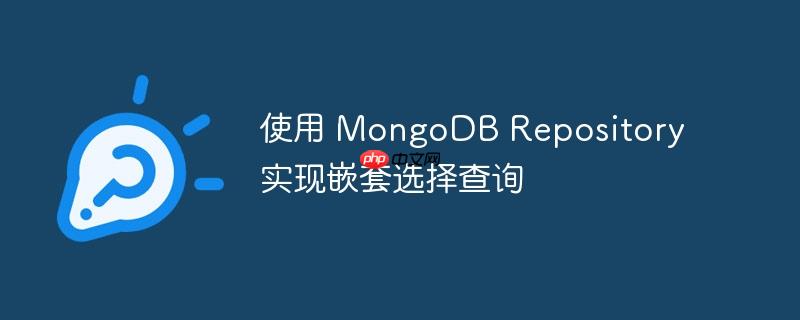
本文介绍了如何使用 spring Data mongodb Repository 和 MongoTemplate 在嵌套的文档结构中执行选择查询。通过示例代码展示了如何根据内嵌文档的字段值查找父文档,并提供了代码示例和使用注意事项,帮助开发者高效地实现复杂查询需求。
在使用 MongoDB 时,经常会遇到需要在嵌套的文档结构中进行查询的场景。例如,我们有一个包含数组字段的文档,数组中的每个元素又是一个包含多个字段的文档。我们需要根据数组中某个元素的字段值来查找包含该元素的父文档。Spring Data MongoDB 提供了强大的工具来应对这种情况,包括 MongoRepository 和 MongoTemplate。
假设我们有以下文档结构:
[{ "id": "classicId", "name": "classicName", "models": [ { "id": "AnotherId", "name": "AnotherSomeName" }, { "id": "RequiredId", "name": "SomeName" } ] }]
我们的目标是,给定 models 数组中某个元素的 id 值,例如 “AnotherId”,找到包含该元素的整个文档。
以下是如何使用 MongoRepository 和 MongoTemplate 实现这个功能的步骤:
- 定义实体类:
首先,我们需要定义一个与文档结构对应的实体类。
import org.springframework.data.annotation.Id; import org.springframework.data.mongodb.core.mapping.Document; import java.util.List; @Document(Collection = "your_collection_name") // Replace with your actual collection name public class YourObject { @Id private String id; private String name; private List<Model> models; // Getters and setters public String getId() { return id; } public void setId(String id) { this.id = id; } public String getName() { return name; } public void setName(String name) { this.name = name; } public List<Model> getModels() { return models; } public void setModels(List<Model> models) { this.models = models; } public static class Model { private String id; private String name; // Getters and setters public String getId() { return id; } public void setId(String id) { this.id = id; } public String getName() { return name; } public void setName(String name) { this.name = name; } } }
- 创建 Repository 接口:
创建一个继承自 MongoRepository 的接口,用于执行数据库操作。
import org.springframework.data.mongodb.repository.MongoRepository; import org.springframework.stereotype.Repository; import java.util.Optional; @Repository public interface YourObjectRepository extends MongoRepository<YourObject, String> { // You can add custom query methods here if needed }
- 使用 MongoTemplate 执行查询:
虽然可以在 Repository 接口中定义自定义查询,但对于这种嵌套查询,使用 MongoTemplate 通常更灵活。 创建一个方法,使用 MongoTemplate 构建查询条件,并执行查询。
import org.springframework.beans.factory.annotation.Autowired; import org.springframework.data.mongodb.core.MongoTemplate; import org.springframework.data.mongodb.core.query.Criteria; import org.springframework.data.mongodb.core.query.Query; import org.springframework.stereotype.Service; import java.util.List; import java.util.Optional; @Service public class YourObjectService { @Autowired private MongoTemplate mongoTemplate; public Optional<YourObject> getByModelId(String theVariableWithTheValue) { Query query = new Query().addCriteria(Criteria.where("models.id").is(theVariableWithTheValue)); List<YourObject> result = mongoTemplate.find(query, YourObject.class); return result.isEmpty() ? Optional.empty() : Optional.of(result.get(0)); } }
代码解释:
- @Autowired private MongoTemplate mongoTemplate;: 注入 MongoTemplate 实例,用于执行 MongoDB 操作。
- Query query = new Query().addCriteria(Criteria.where(“models.id”).is(theVariableWithTheValue));: 创建一个 Query 对象,并使用 Criteria.where(“models.id”).is(theVariableWithTheValue) 定义查询条件。 “models.id” 表示查询 models 数组中 id 字段等于 theVariableWithTheValue 的元素。
- List<YourObject> result = mongoTemplate.find(query, YourObject.class);: 使用 mongoTemplate.find() 方法执行查询,将结果映射到 YourObject 类型的列表。
- return result.isEmpty() ? Optional.empty() : Optional.of(result.get(0));: 如果查询结果为空,返回 Optional.empty(),否则返回包含第一个结果的 Optional<YourObject>。
使用示例:
@Autowired private YourObjectService yourObjectService; public void someMethod() { String modelId = "AnotherId"; Optional<YourObject> yourObject = yourObjectService.getByModelId(modelId); if (yourObject.isPresent()) { System.out.println("Found object: " + yourObject.get().getName()); } else { System.out.println("Object not found for model id: " + modelId); } }
注意事项:
- 确保实体类的字段名与 MongoDB 文档中的字段名一致。
- 如果 models 数组中的 id 不是唯一的,该查询将返回第一个匹配的文档。 如果需要返回所有匹配的文档,可以使用 mongoTemplate.findAll() 方法。
- @Document(collection = “your_collection_name”) 注解中的 your_collection_name 需要替换为实际的集合名称。
- 在实际应用中,需要处理查询结果为空的情况,避免空指针异常。
总结:
通过使用 MongoTemplate 和 Criteria,我们可以轻松地在 MongoDB 中执行复杂的嵌套查询。 本文提供的示例代码可以作为基础,根据实际需求进行修改和扩展。 掌握这些技巧可以帮助开发者更高效地使用 Spring Data MongoDB 操作 MongoDB 数据库。


评论(已关闭)
评论已关闭